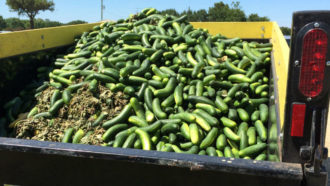RALEIGH, North Carolina -- The Center for Environmental Farming Systems (CEFS) Whole Crop Harvest initiative has released a new video to encourage farmers to donate produce to food banks. Donations to food banks provide alternatives for farmers when they are unable to sell all of their fresh produce, says Rebecca Dunning, a North Carolina State University horticulturist.
The video is an educational resource that is part of a Southern SARE-funded Research and Education grant, (LS17-280), "A Supply Chain Approach to Finding Win-win Sustainable Solutions for Edible But Unharvested Produce." The goal of the project is to increase the economic and environmental sustainability of produce growers by developing and disseminating approaches to utilize produce that typically goes unharvested.
"The audience is mid-to-large scale produce growers who currently do not donate product to food banks. In our work interviewing these growers in North Carolina, we found that growers were not aware of the capacity of regional food banks to efficiently pick up and handle large volumes, and some growers were unaware of the tax benefits and release from liability associated with donation," said Dunning. “No one likes to see food, especially healthy nutritious food, go to waste, and that includes the farmers who produce it."
Dunning and others at CEFS and NCSU have been working with produce growers and supply chain intermediaries to discover ways to utilize farm surplus that can economically benefit farmers, who often operate on razor-thin margins. “We know growers would definitely prefer to sell everything they have, but if that’s not possible, donation to food banks can be a win-win,” said Dunning. “The food bank can distribute fresh foods, while growers get a tax deduction and minimize costs of disposal.”
The Whole Crop Harvest initiative focuses on minimizing on-farm losses of fresh produce in ways that economically benefit growers. The project is funded by the USDA’s SARE program.
Article contributed by JJ Richardson, Center for Environmental Farming Systems Communications and Website Manager, jblevinr@ncsu.edu
Published by the Southern Region of the Sustainable Agriculture Research and Education (SARE) program. Funded by the USDA National Institute of Food and Agriculture (NIFA), Southern SARE operates under cooperative agreements with the University of Georgia, Fort Valley State University, and the Kerr Center for Sustainable Agriculture to offer competitive grants to advance sustainable agriculture in America's Southern region. This material is based upon work that is supported by the National Institute of Food and Agriculture, U.S. Department of Agriculture, through Southern Sustainable Agriculture Research and Education, under sub-award number: LS17-280. USDA is an equal opportunity employer and service provider. Any opinions, findings, conclusions, or recommendations expressed in this publication are those of the author(s) and do not necessarily reflect the view of the U.S. Department of Agriculture.
